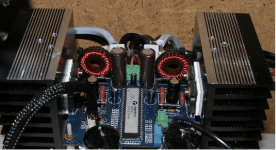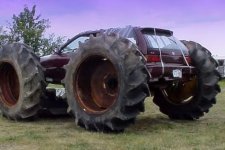good caps are cheap 100uf 100v 12.52€ https://www.mouser.it/ProductDetail/KEMET/F611RP107M100Z?qs=wo4x%2BUeoG8WpOUXiMBBMaQ==
just build se tube amp and test on input/driver stage katode the cheap elna cerafine or Oscon no bias here will sound total different!Hi Tony,
So have I, and I have had to remove them and install proper Electrolytic capacitors. They do not fit, pure and simple. That and everyone I have sen that installed them does a really poor service job. They just read cr*p on the internet and execute things without any thought at all. I've also had to remove bypass capacitors all over the place in old amplifiers. More so these days. Measured performance has shown they do not improve performance and can often introduce abnormal peaks and couplings with the signal. So the takeaway here is simple. You simply cannot blindly change capacitor types or add bypass capacitors without understanding clearly what you are doing - and more importantly, checking for problems you may have introduced. That means you need the proper test equipment and knowledge to perform that work.
Electrolytic capacitors have areas they do very well in, and bulk storage is one of them. It comes down to using the proper component in it's place, and there is no one "best " type of capacitor.
-Chris
then put the same value 100uf or claitycaps ....so simple diy audio
Hi nicoch58,
No offense intended here at all, but why on earth would anyone build a circuit design that was proved in the 1920's to be substandard to a p-p circuit? This in distortion and efficiency! Now, if you do like that type of distortion, I can't imagine how you could be so incredibly picky over similar capacitor types, or even completely different families!
Considering this, you are asking others to go to the considerable expense and effort to build such a limited item to hear what is more easily detected using a lower distortion amplifier is beyond me. In fact, a very low distortion solid state amplifier, class A-B with superior sonic qualities would be a far better test bed for your assertions. That way you would at least be able to hear the differences! In your application I can only assume expectation bias is the only thing at work here as the distortion from the amplifier absolutely does swamp contributions from the capacitors you mentioned. This is something I actually know for certain from a practical standpoint. I'm not a theoretical only guy, I listen and measure as well as consider opinions from others.
I am not trying to pick a fight with someone obviously heavily invested in single-ended tube technology, but I am extremely familiar with these amplifiers and service the latest ones even today. So you are not talking with someone who is unfamiliar with how these sound and operate (or the running costs of these types of amplifiers). I work on all types of amplification and view them from a sonic standpoint along with reliability and cost of ownership. If I exclude the cost of ownership, single-ended amplifiers still have very little to recommend them.
Finally, yes. I can certainly hear the differences between capacitor types in places where they actually do affect the sound quality. This is always easily measurable as well (and I do). Now, you are aware that Oscons and electrolytics have different electrical characteristics, as to the film capacitors you referenced. The other thing you have to get a grip on is that price has nothing to do with quality. Some components are more expensive to manufacture and ship, plus there is a sales volume aspect also. Each capacitor type has areas where they are the best choice. There are many times where the improved characteristics do not matter ata ll, but he increased size and component lead size / weight absolutely does. So your comment " the cheap elna cerafine or Oscon" indicates you really have no understanding of this at all.
"Oscon" refers specifically to a Sanyo product, and several other excellent manufacturers make very similar products (same family type). So are the other ones good, or are you only aware of these? I know earlier audio press made a big deal out of Oscon capacitors and maybe that is why you are aware of them. I've tested these types from the start, all brands. I use them where they are suited with excellent results.
- Chris
No offense intended here at all, but why on earth would anyone build a circuit design that was proved in the 1920's to be substandard to a p-p circuit? This in distortion and efficiency! Now, if you do like that type of distortion, I can't imagine how you could be so incredibly picky over similar capacitor types, or even completely different families!
Considering this, you are asking others to go to the considerable expense and effort to build such a limited item to hear what is more easily detected using a lower distortion amplifier is beyond me. In fact, a very low distortion solid state amplifier, class A-B with superior sonic qualities would be a far better test bed for your assertions. That way you would at least be able to hear the differences! In your application I can only assume expectation bias is the only thing at work here as the distortion from the amplifier absolutely does swamp contributions from the capacitors you mentioned. This is something I actually know for certain from a practical standpoint. I'm not a theoretical only guy, I listen and measure as well as consider opinions from others.
I am not trying to pick a fight with someone obviously heavily invested in single-ended tube technology, but I am extremely familiar with these amplifiers and service the latest ones even today. So you are not talking with someone who is unfamiliar with how these sound and operate (or the running costs of these types of amplifiers). I work on all types of amplification and view them from a sonic standpoint along with reliability and cost of ownership. If I exclude the cost of ownership, single-ended amplifiers still have very little to recommend them.
Finally, yes. I can certainly hear the differences between capacitor types in places where they actually do affect the sound quality. This is always easily measurable as well (and I do). Now, you are aware that Oscons and electrolytics have different electrical characteristics, as to the film capacitors you referenced. The other thing you have to get a grip on is that price has nothing to do with quality. Some components are more expensive to manufacture and ship, plus there is a sales volume aspect also. Each capacitor type has areas where they are the best choice. There are many times where the improved characteristics do not matter ata ll, but he increased size and component lead size / weight absolutely does. So your comment " the cheap elna cerafine or Oscon" indicates you really have no understanding of this at all.
"Oscon" refers specifically to a Sanyo product, and several other excellent manufacturers make very similar products (same family type). So are the other ones good, or are you only aware of these? I know earlier audio press made a big deal out of Oscon capacitors and maybe that is why you are aware of them. I've tested these types from the start, all brands. I use them where they are suited with excellent results.
- Chris
is relate to your mito of bias on component just a simple example that esist only for feeble or kid minds
I prefear cheap koa vs duelund resistor on mySS9800 go figure ,before ask we know well that are not the same ,no need a lesson oscon are around 15y min 😛
we like 300b as sit amp by Nelson ,as Acamini as my borbley amp ,Naka too
I prefear cheap koa vs duelund resistor on mySS9800 go figure ,before ask we know well that are not the same ,no need a lesson oscon are around 15y min 😛
we like 300b as sit amp by Nelson ,as Acamini as my borbley amp ,Naka too
if you are happy my diy old Tripath sound a lot better with input cheap clarity caps vs the panasonic elko and better with bypas mundorf s/oHi nicoch58,
No offense intended here at all, but why on earth would anyone build a circuit design that was proved in the 1920's to be substandard to a p-p circuit? This in distortion and efficiency! Now, if you do like that type of distortion, I can't imagine how you could be so incredibly picky over similar capacitor types, or even completely different families!
Considering this, you are asking others to go to the considerable expense and effort to build such a limited item to hear what is more easily detected using a lower distortion amplifier is beyond me. In fact, a very low distortion solid state amplifier, class A-B with superior sonic qualities would be a far better test bed for your assertions. That way you would at least be able to hear the differences! In your application I can only assume expectation bias is the only thing at work here as the distortion from the amplifier absolutely does swamp contributions from the capacitors you mentioned. This is something I actually know for certain from a practical standpoint. I'm not a theoretical only guy, I listen and measure as well as consider opinions from others.
I am not trying to pick a fight with someone obviously heavily invested in single-ended tube technology, but I am extremely familiar with these amplifiers and service the latest ones even today. So you are not talking with someone who is unfamiliar with how these sound and operate (or the running costs of these types of amplifiers). I work on all types of amplification and view them from a sonic standpoint along with reliability and cost of ownership. If I exclude the cost of ownership, single-ended amplifiers still have very little to recommend them.
Finally, yes. I can certainly hear the differences between capacitor types in places where they actually do affect the sound quality. This is always easily measurable as well (and I do). Now, you are aware that Oscons and electrolytics have different electrical characteristics, as to the film capacitors you referenced. The other thing you have to get a grip on is that price has nothing to do with quality. Some components are more expensive to manufacture and ship, plus there is a sales volume aspect also. Each capacitor type has areas where they are the best choice. There are many times where the improved characteristics do not matter ata ll, but he increased size and component lead size / weight absolutely does. So your comment " the cheap elna cerafine or Oscon" indicates you really have no understanding of this at all.
"Oscon" refers specifically to a Sanyo product, and several other excellent manufacturers make very similar products (same family type). So are the other ones good, or are you only aware of these? I know earlier audio press made a big deal out of Oscon capacitors and maybe that is why you are aware of them. I've tested these types from the start, all brands. I use them where they are suited with excellent results.
- Chris
Attachments
I'm merely commenting on your "easy DIY test", which is an extreme thing to ask of anyone. A poorly suggested test in my view guarantied to be left unanswered.
My other comments stand as they are valid. What you think sounds better is really only valid for you. If you are arguing a matter of taste you begin an endless argument without resolution.
We are reproducing a signal (we call it music). Reproduction with the lowest distortion is the goal and by definition will sound the best to an impartial observer. Some people prefer a particular "sound", which if different from low distortion reproduction is distortion - by definition. I can't fault you for that and I won't. However you are in a poor position to recommend this to others. You do stand apart from the bulk of the population and not because you enjoy what you believe to be low distortion reproduction. That is your right but you are in the minority. You best accept and understand that. If this wasn't true we would still be listening to tube amplifiers using 50C5 (or 50L6GT) in single-ended mode. We all had at least one of those when young if we're old enough to speak with any authority on this subject. Yours are just larger but follow the exact same principles of operation. One characteristic is the introduction of large amounts of distortion, far more than a capacitor will produce. So for the purposes of this discussion I find it difficult to equate your findings to reality.
-Chris
My other comments stand as they are valid. What you think sounds better is really only valid for you. If you are arguing a matter of taste you begin an endless argument without resolution.
We are reproducing a signal (we call it music). Reproduction with the lowest distortion is the goal and by definition will sound the best to an impartial observer. Some people prefer a particular "sound", which if different from low distortion reproduction is distortion - by definition. I can't fault you for that and I won't. However you are in a poor position to recommend this to others. You do stand apart from the bulk of the population and not because you enjoy what you believe to be low distortion reproduction. That is your right but you are in the minority. You best accept and understand that. If this wasn't true we would still be listening to tube amplifiers using 50C5 (or 50L6GT) in single-ended mode. We all had at least one of those when young if we're old enough to speak with any authority on this subject. Yours are just larger but follow the exact same principles of operation. One characteristic is the introduction of large amounts of distortion, far more than a capacitor will produce. So for the purposes of this discussion I find it difficult to equate your findings to reality.
-Chris
Dynaco mark 4 diy..
see how the main tube rectified psu is implemented with film caps....
i can see electros in the output tube boards still...
i would say an improvement of how to do things...
this is my path moving forward....
in MY AMP i will use whatever i want as long as physics is not violated...
see how the main tube rectified psu is implemented with film caps....
i can see electros in the output tube boards still...
i would say an improvement of how to do things...
this is my path moving forward....
in MY AMP i will use whatever i want as long as physics is not violated...
just build se tube amp and test on input/driver stage katode the cheap elna cerafine or Oscon no bias here will sound total different!
then put the same value 100uf or claitycaps ....so simple diy audio
film caps is not for everyone it seems, i will never go around the net telling people they should...
My other comments stand as they are valid. What you think sounds better is really only valid for you. If you are arguing a matter of taste you begin an endless argument without resolution.
fair comment...my thoughts too...
Hi Tony,
No arguments from me. What is nice about a tube rectifier is the inherent resistance which damps spikes. You don't need film caps in that situation, or you can bypass the main filter cap. I add resistance in series with solid state rectifiers in many situations to allow for the same effect. Not in situations were the current demands are large and dynamic of course!
My biggest complaint is the size of a film cap installed in existing designs. There isn't room without compromising ventilation. A new design is on the designer, but you must consider air flow. I think that using a bypass capacitor gives you the best of both worlds - done neatly! The other thing I have seen is capacitors used that require the supply voltage be reduced. Methods to do this are pretty silly at times.
All,
Film capacitors need to be used with some thought, they are not better than an electrolytic in every application, especially new electrolytics of good quality. Like anything (resistors included folks!), you have to understand the part and the circuit. Sometimes the benefits you imagine do not come into play.
To each their own, just do not impair the performance of the equipment. Especially do not do the work on anyone else's equipment! That is irresponsible in my view. You need to be an engineering technician when performing modifications as that is the only time when the person doing he work really does understand fully what they are doing. This isn't about belief, it is about doing correct work.
-Chris
No arguments from me. What is nice about a tube rectifier is the inherent resistance which damps spikes. You don't need film caps in that situation, or you can bypass the main filter cap. I add resistance in series with solid state rectifiers in many situations to allow for the same effect. Not in situations were the current demands are large and dynamic of course!
My biggest complaint is the size of a film cap installed in existing designs. There isn't room without compromising ventilation. A new design is on the designer, but you must consider air flow. I think that using a bypass capacitor gives you the best of both worlds - done neatly! The other thing I have seen is capacitors used that require the supply voltage be reduced. Methods to do this are pretty silly at times.
All,
Film capacitors need to be used with some thought, they are not better than an electrolytic in every application, especially new electrolytics of good quality. Like anything (resistors included folks!), you have to understand the part and the circuit. Sometimes the benefits you imagine do not come into play.
To each their own, just do not impair the performance of the equipment. Especially do not do the work on anyone else's equipment! That is irresponsible in my view. You need to be an engineering technician when performing modifications as that is the only time when the person doing he work really does understand fully what they are doing. This isn't about belief, it is about doing correct work.
-Chris
a capacitor is a capacitor, is a capacitor and a capacitor.....
the most powerful rule is the voltage rating, do not impress voltage on your capacitor that will make it explode,
if you can obey this, you are good to go...
caps i intend to use in my tube amps....not for use in existing amps, new designs and builds can surely use these...
the most powerful rule is the voltage rating, do not impress voltage on your capacitor that will make it explode,
if you can obey this, you are good to go...
caps i intend to use in my tube amps....not for use in existing amps, new designs and builds can surely use these...
Attachments
-
 324448144_1252626595336475_5208849067151357051_n.jpg257.9 KB · Views: 106
324448144_1252626595336475_5208849067151357051_n.jpg257.9 KB · Views: 106 -
 324218067_570354361610900_7967754031358036024_n (1).jpg232.6 KB · Views: 102
324218067_570354361610900_7967754031358036024_n (1).jpg232.6 KB · Views: 102 -
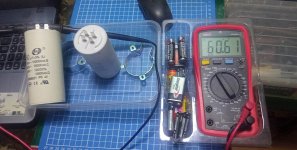 323752573_1589735564809681_3521515193969187559_n (1).jpg237 KB · Views: 101
323752573_1589735564809681_3521515193969187559_n (1).jpg237 KB · Views: 101 -
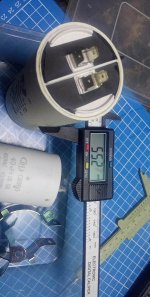 323938036_3531905447043429_2209127770341056365_n.jpg236.6 KB · Views: 117
323938036_3531905447043429_2209127770341056365_n.jpg236.6 KB · Views: 117 -
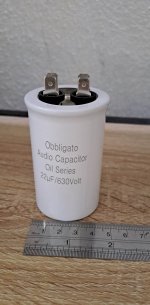 317373086_2488377984634829_2711068879175834634_n.jpg118 KB · Views: 124
317373086_2488377984634829_2711068879175834634_n.jpg118 KB · Views: 124
Last edited:
Hi Tony,
LOL!
Yep, I pulled out a set of those. The voltage rating wasn't high enough - so you are more than right on that score!
For your own builds where you have left room for ventilation - absolutely! Go for it.
However I disagree that a capacitor is a capacitor is a capacitor. They do have different characteristics that can occasionally cause unplanned interactions. It isn't a matter of cost at all. You use the proper capacitor in the proper location in a circuit. That's all.
LOL!
Yep, I pulled out a set of those. The voltage rating wasn't high enough - so you are more than right on that score!
For your own builds where you have left room for ventilation - absolutely! Go for it.
However I disagree that a capacitor is a capacitor is a capacitor. They do have different characteristics that can occasionally cause unplanned interactions. It isn't a matter of cost at all. You use the proper capacitor in the proper location in a circuit. That's all.
a capacitor is simply two parallel plates with a dielectric insulation in between, what could be complicated about that?
imho, the complications are in the minds of folks attributing things to capacitors based on their beliefs and biases...
“beliefs”imho, the complications are in the minds of folks attributing things to capacitors based on their beliefs and biases...
Which include resonance, or poor bandwidth…
On my cars, I always say “a tire is a tire is a tire”
Attachments
based on my belief, polypropylenes are good caps, that is after reading the 1980 Audio magazine article on picking capacitors...https://www.reliablecapacitors.com/information/picking-capacitors.html
That was a good article. It is backed up by measurements on different capacitor types. You are correct, but again those characteristics are not the best for all applications.
I buy very good tires for my cars, they make all the difference in the world! Notice I didn't state a brand, not wanting to get into that kind of discussion ...
Those are good for getting through traffic jams! lol!On my cars, I always say “a tire is a tire is a tire”
I buy very good tires for my cars, they make all the difference in the world! Notice I didn't state a brand, not wanting to get into that kind of discussion ...
Never do , that's diya forum people can do his experience and share is finding .film caps is not for everyone it seems, i will never go around the net telling people they should...
lucky my is the same on what I read on 1300 thread and more maybe that I read in this 18y here ,lucky too JCurl and Borbley have the same taste ...
On thd Nelson have some nice reading that can educate some here
- Home
- Design & Build
- Parts
- Best electrolytic capacitors
